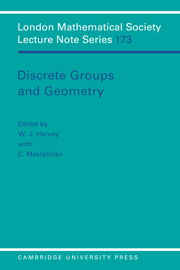Book contents
- Frontmatter
- Contents
- Preface
- Symmetries of modular surfaces
- Lifting group actions to covering spaces
- A combinatorial approach to the symmetries of M and M–l Riemann surfaces
- Inequalities for Pell equations and Fuchsian groups
- The Euler characteristic of graph products and of Coxeter groups
- Infinite families of automorphism groups of Riemann surfaces
- Planar hyperelliptic Klein surfaces and fundamental regions of NEC groups
- An example of an infinite group
- Moduli of Riemann surfaces with symmetry
- Modular groups – geometry and physics
- On automorphisms of free products
- The growth series of the Gieseking group
- Exceptional representations of PSL2(q) of monodromy genus zero
- On the rank of NEC groups
- The geometry of bending quasi-Fuchsian groups
- Farey series and sums of continued fractions
- Commensurability classes of two-generator Fuchsian groups
- Limit points via Schottky pairings
- Diagonalizing Eisenstein series III
- Some remarks on 2-generator hyperbolic 3-manifolds
- Uniformization, graded Riemann surfaces and supersymmetry
- Generating sets for finite groups
- Group actions on trees with and without fixed points
Uniformization, graded Riemann surfaces and supersymmetry
Published online by Cambridge University Press: 10 December 2009
- Frontmatter
- Contents
- Preface
- Symmetries of modular surfaces
- Lifting group actions to covering spaces
- A combinatorial approach to the symmetries of M and M–l Riemann surfaces
- Inequalities for Pell equations and Fuchsian groups
- The Euler characteristic of graph products and of Coxeter groups
- Infinite families of automorphism groups of Riemann surfaces
- Planar hyperelliptic Klein surfaces and fundamental regions of NEC groups
- An example of an infinite group
- Moduli of Riemann surfaces with symmetry
- Modular groups – geometry and physics
- On automorphisms of free products
- The growth series of the Gieseking group
- Exceptional representations of PSL2(q) of monodromy genus zero
- On the rank of NEC groups
- The geometry of bending quasi-Fuchsian groups
- Farey series and sums of continued fractions
- Commensurability classes of two-generator Fuchsian groups
- Limit points via Schottky pairings
- Diagonalizing Eisenstein series III
- Some remarks on 2-generator hyperbolic 3-manifolds
- Uniformization, graded Riemann surfaces and supersymmetry
- Generating sets for finite groups
- Group actions on trees with and without fixed points
Summary
Abstract. A projective structure on a Riemann surface M is achieved by lifting to a universal covering space of M the ratio of solutions of a linear differential equation defined on the surface. We show that these solutions, and vector fields preserving the projective structure induced on M, define a sheaf of graded Lie algebras. At the same time, we construct a sheaf of graded Lie algebras over the Teichmüller family of Riemann surfaces, which is related to the process of simultaneous uniformization for the family. This structure constitutes a modular supersymmetry, an extended notion of local sl2-symmetry, which is motivated by Grand Unification Theory in theoretical physics.
Introduction
A projective structure on a Riemann surface M is a reduction of its pseudo-group of holomorphic coordinate transformations to the group of fractional linear transformations PL(2,C). On a Riemann surface of genus g > 2, this can be achieved by choosing a projective connection, an element of an affine space over the vector space of globally defined holomorphic quadratic differentials [7]. A new complex atlas on M with projective coordinate transformations is obtained by composing the old coordinates with the ratio of two linearly independent solutions of a differential equation defined on the surface.
A significant fact, proved in [9], is that solutions of such a uniformizing equation must be local spinors, sections of a square root of the tangent bundle of M.
- Type
- Chapter
- Information
- Discrete Groups and Geometry , pp. 220 - 233Publisher: Cambridge University PressPrint publication year: 1992



